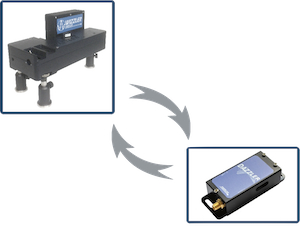
Pulse compression loop
Dazzler / Wizzler combination for automated pulse compression optimization
The combination of the Dazzler pulse shaping capabilities with the Wizzler high dynamic range measurement provides the most powerful compression optimization tool.
A Wizzler single shot measurement data is sent to the Dazzler software, with user-defined phase attenuation and filtering. Phase correction is then applied by the Dazzler.
With just few clicks, the Wizzler / Dazzler feedback loops warranties FTL pulses with high contrast everyday from your amplifier or your OPA with an unprecedented level of control on a dynamic range over 40dB.
Combining the Dazzler, located in the amplifier front-end, and the Wizzler, measuring the pulse after the final compression stage, provides the most powerful pulse compresion optimization technique.
A pulse duration commonly refers to a value linked to its full width at half maximum value (FWHM). It is however well known that this parameter does not represent the quality of a femtosecond pulse, or of an ultrafast laser. Furthermore, the number of applications requiring accurate pulse characterization well beyond its FWHM has been steadily increasing over the past decade. The Wizzler, thanks to its superior dynamic range, provides the pulse duration characteristics over 40dB from the pulse peak intensity.
Fastlite, with its Wizzler product line, introduces the use of the standard deviation (sigma) of the time-intensity profile over the complete temporal window of the measurement to gain insights on the quality of your pulse.
Comparing this measured value with the FTL sigma value on the same temporal window quantifies the loss of coherent contrast due to phase aberrations, and provides a good indication of the pulse compression quality at several orders of magnitude below the main peak intensity.
While performing a pulse compression optimization using the Wizzler & Dazzler feedback loop, one can observe the reduction of the standard deviation of the compressed pulse at each feedback iteration.
When the pulse is fully compressed, the measured standard deviation is lowered down to the FTL value, meaning that pre-pulses have been reduced and pulse peak intensity has been maximized.
The video below shows a real time compression optimization of a mJ-level Ti:Sa system using the Wizzler & Dazzler loop.
Legend:
– Upper graph: spectral domain. white: intensity, red: phase
– Lower graph: Temporal domain: white: intensity, red: FTL intensity
Large-scale laser systems can be quite sensitive to alignment and environmental conditions. This is one of the main reasons why experimental results are hard to reproduce from day to day.
The Wizzler / Dazzler feedback loop can re-optimize the pulse compression within few minutes with an unprecedented level of control, thus garantying the same laser temporal characteristics every day.
| Most of CPA systems operate in the saturation regime to extract more energy with a better stability. However, this adds coupling effects and non-linearities, and makes direct correction of the phase unpracticable.
With all necessary knobs and filters to balance the non-linear phase transfer and coupling effects during the laser amplification process, the Dazzler-Wizzler feedback loop has proved its effectiveness on more than a 100 lasers systems worldwide. |
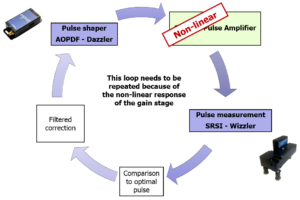 |
| The measurement below illustrates the outstanding spectral phase aberrations correction capabilities of the Wizzler & Dazzler feedback loop. The measured laser shows a Pi phase jump around 780nm, resulting in a dramatic loss of contrast and peak energy of the ultrafast pulse. |
||
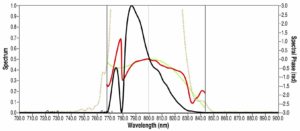 |
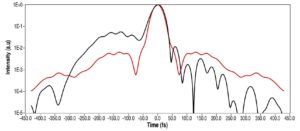 |
|
|
After optimization using the Wizzler & Dazzler feedback loop, the Pi phase jump has been compensated for, and the pulse is Fourier-Transform-Limited on the +/-450fs time window.
|
||
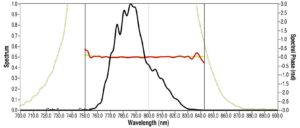 |
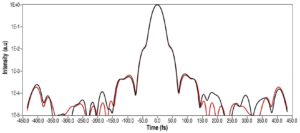 |
|
| Click on the image to download the « Wizzler & Dazzler feedback loop data booklet », showing experimental results on many types of ultrafast lasers, |
Once the pulse compression has been optimized using the Wizzler & Dazzler loop, a small drift of the spectral phase can ruin the most phase-sensitive experiments such as non-linear effect generation.
This phase stabilization software, including all the necessary safety checks, automatically corrects for the slow drifts of low order phase distortions, so that the laser pulse remains perfectly compressed all along the experiment campaign.
| A. Moulet et al: « Single-shot, high-dynamic-range measurement of sub-15 fs pulses by self-referenced spectral interferometry » Opt.Lett. (2010) |
For a list of user publications, click here.
